Digging into Data
Professional Writers as Data Users
Laura Gonzales and Dànielle Nicole DeVoss
Recent work in rhetoric and composition, specifically computers and writing, has addressed how students are often both under digital surveillance and are generators of significant data, frequently in ways they are unaware of. This data is put to use by a range of audiences, primarily by marketers and primarily to connect students to products (it's no coincidence that if you post a message about a favorite food on social media that you start seeing ads for restaurants selling that type of food). In an effort to bring attention to these important issues, researchers in rhetoric and composition and other fields have developed tools and strategies to help students make smarter decisions about how they use and share their data on the Internet (Beck, 2015; McKee, 2011; Vee, 2010).
In this piece we argue that as much as we need—as composition instructors and professors of professional, technical, and scientific communication—to help students understand the data traces they leave behind in digital space, we also need to equip students to be ethical, rhetorical users of data. Indeed, many of our students pursue careers in web development, social media management, software development, and other areas where they collect and put to use user data.
Introduction
For a Town Hall session at the Computers and Writing 2015 Conference, Estee Beck, Angela Crow, Jennifer deWinter, Laura Gonzales, Heidi McKee, Colleen Reilly, and Stephanie Vie focused on issues of surveillance, privacy, and net neutrality. These issues were compellingly addressed, historically scaffolded, and both theoretically and pragmatically approached.
Students were situated in the context of the Town Hall as primarily consumers of and users of digital media—individuals who, to be technoliterate, require critical, informed approaches to how the data they offer is put to use. Certainly, we and our students leave trails of data, much of it invisible to us, across the digital spaces we visit, shop at, and share across.
Admittedly, we do need to situate students as consumers of digital media and help them to understand what data they generate and produce and how that data is used. However, we also need to recognize that our students are users of that data: that they need to be able to collect, analyze, and put to use data. As we consider the shifting approaches to technological literacy that have been discussed over the past 20 years in Kairos, we aim to reposition students from being situated most often as merely consumers and sharers of user data to being situated as the creators and facilitators of technologies that make use of digital data.
Highlights, Part 1
Issues of online panopticons, digital surveillance, and privacy have been approached both by computers and writing and by technical communication scholars. Much of the current literature runs parallel to the focus of the Town Hall panel—that is, focused on how user data is collected and put to use, with an emphasis on students as data generators.
Tim Amidon and Jessica Reyman (2014), for instance, discussed authorship and ownership of user data. One example they offered relates to a tweet: "The data from a single tweet includes the tweet's unique ID, the text of the tweet, the tweet's creation date, the author's user and screen names, the number of tweets the author has sent, the author's 'location'… and much more information" (p. 109). Amidon and Reyman also called attention to social sites's terms of use, which often allow site owners to gather, store, and even share user data.
Estee Beck (2015) traced the impact of tracking technologies on users' “invisible digital identity,” which she explained as the algorithms used by companies to target advertisements based on users' Internet searches. Through this work, Beck provides a useful framework to help teachers educate students about their options regarding sharing data online, pushing for us and our students to “take back our digital identities” as informed consumers (p. 138).
Johndan Johnson-Eilola (2012) explored the ways in which we can take hold of and shake up texts in digital contexts—where we can “fragment, unmake, and remake.” In one node within his rich hypertext, he described how we “trade privacy for ease of use,” especially when we encounter lengthy and complex end-use agreements. In another, he discussed marketing studies where shoppers were tracked, unbeknownst to them, by identifying codes on their cellphones. In yet another, he described the ways in which web server software tracks our clicks, movements, and pauses, describing how, “from an author's standpoint, we'll gain better understandings of how people move through our own texts” (n.p.).
As students continue moving into positions that require them to collect, analyze, and leverage user data, there is a need to provide further support for individuals aiming to navigate user information rhetorically, ethically, and professionally.
Highlights, Part 2
As students appear as the collectors and users of data, we would be mindful of the following:
1. Search engine analytics offer information about
how users search for information: This information
is incredibly important to
organizations—businesses and nonprofits, for
instance—to better understand how users find
their way to their web sites and information on
their sites. Understanding the search terms users
generate and put to use to access information can
help organizations better integrate the terminology
used by users (see, e.g., Morsello,
2015).
2. Internal site search analytics provide search
information—for instance, number of searches
performed and type of search (basic vs. advanced).
Understanding how users
search for and access information internally on a
site can help organizations create site structure
and hierarchy more oriented toward users. Figure 1
is a section of a Digital Rhetoric Collaborative
audience segmentation report, designed to help
interns better understand the site's audiences. The report outlines audience segments according to new versus returning users, traffic by device, and locations from which audiences search.
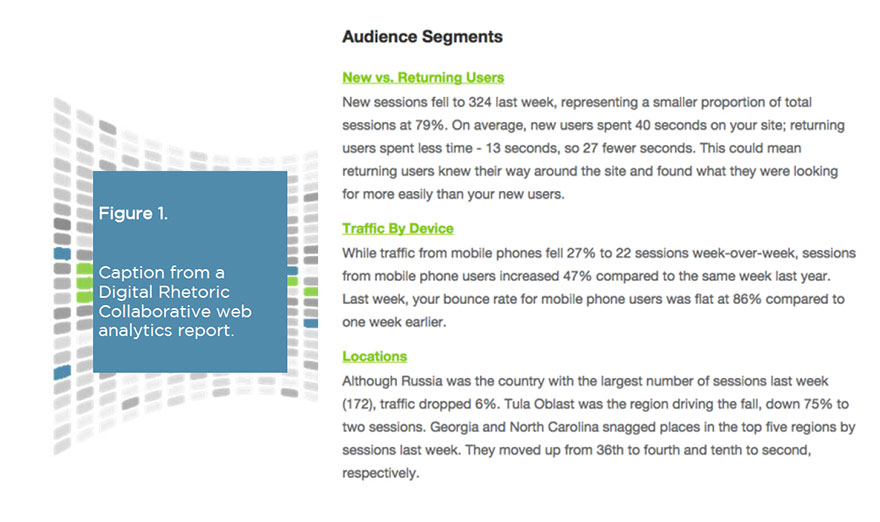
Fig. 1. Caption from a Digital Rhetoric Collaborative web analytics report showing audience segments.
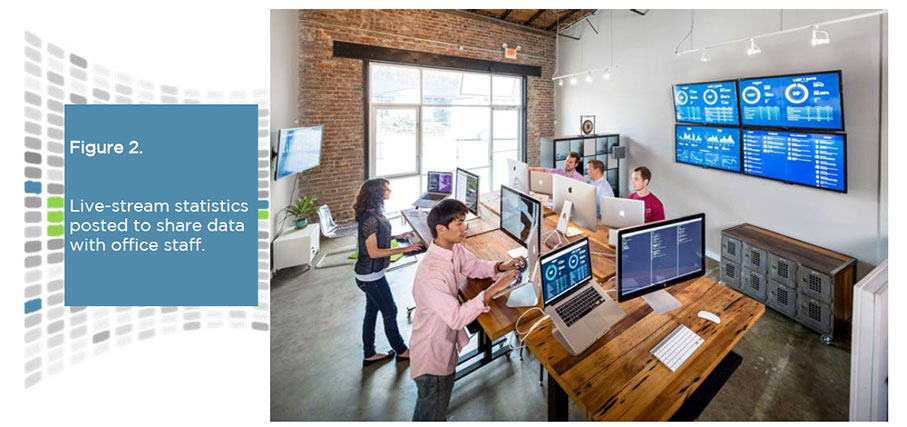
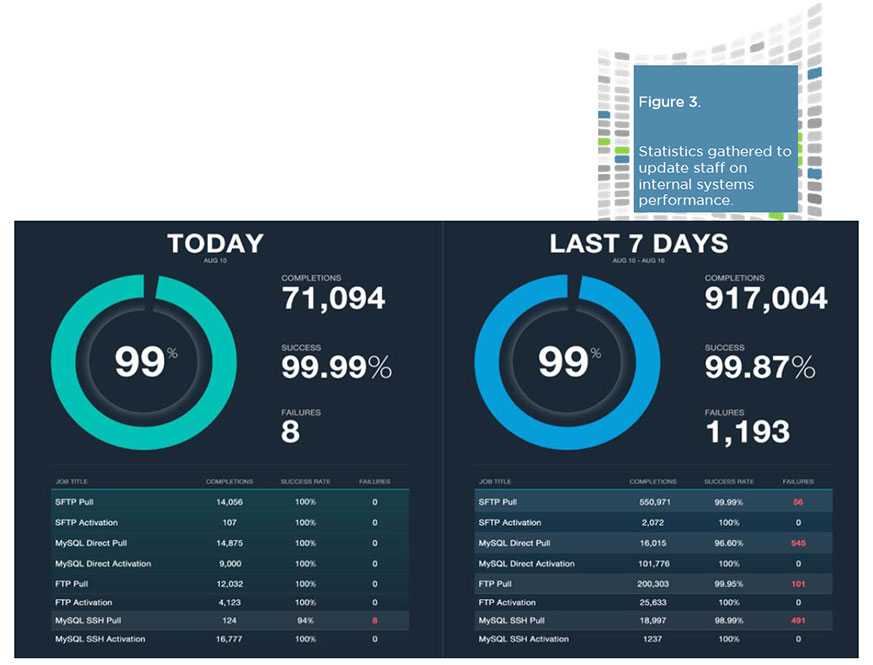
4. Digital analytics can inform the ways in which an organization operates within a community: For instance, in a 2010 report focused on a communication strategy overview, student communication interns for the Michigan State University Department of Writing, Rhetoric, and American Cultures provided an analytic-based report offering recommendations for the chair of the department to consider. An excerpt is included in the block quote below, and one small piece of analytic data is included in Figure 4.
• Improve Analytic Data Collection—drastic improvement is needed in the keeping and processing of analytic data about community engagement. This report will present a significant amount of data about community activity, but the data potential in our content sources has yet to be adequately organized. A plan must be developed for how this data is collected, reported, and assessed. Specifically, the following areas are places where data isn't currently gathered, but could be.
• Mapping Website/Blog Access—despite early intentions, as of now there is no data available about use of the WRAC blog. An analytic package, ideally Google Analytics, should be implemented right away to begin observing what content people access and how frequently they do it.
• Improving Cross-Platform Analysis—as of now, WRAC analytic data is only collected on an individual platform basis, meaning that it will only paint a picture of the use of one service. In the future, it would be ideal to see, for example, how often a single blog post is visited on the website, “liked” on Facebook, and clicked on in a Tweet.
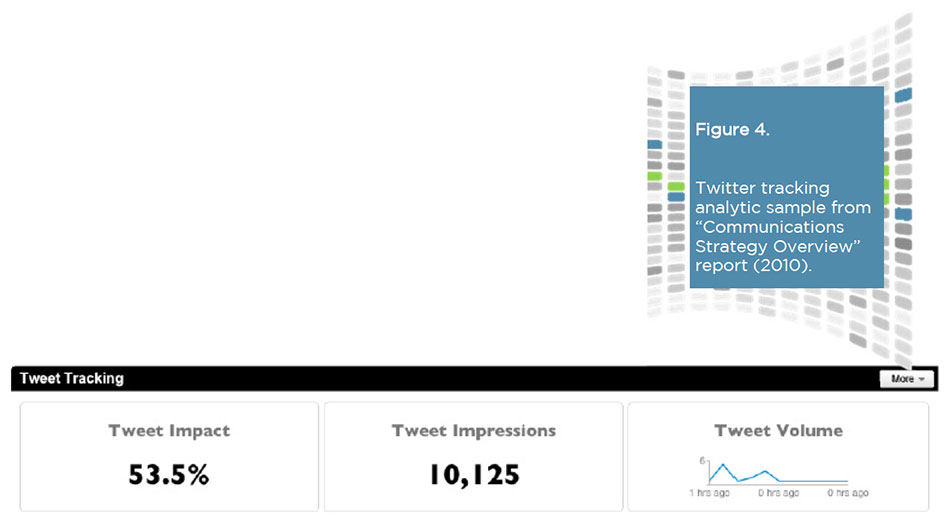
Highlights, Part 3
Not only do students in our professional and technical writing classes put to use different types of analytic data, they also often—as part of their purview and tasks—help others within the organization understand this data. For instance, one of the interns who worked on the 2010 report (see the block quote above and Fig. 4)— Alexandra White, Professional Writing Alum, '11—produced, some years later, a key to the analytics reports she produced in her position. Figure 5 is an excerpt from one of the analytics reports she regularly produces; Figure 6 is an excerpt from a key she created for readers of the reports.
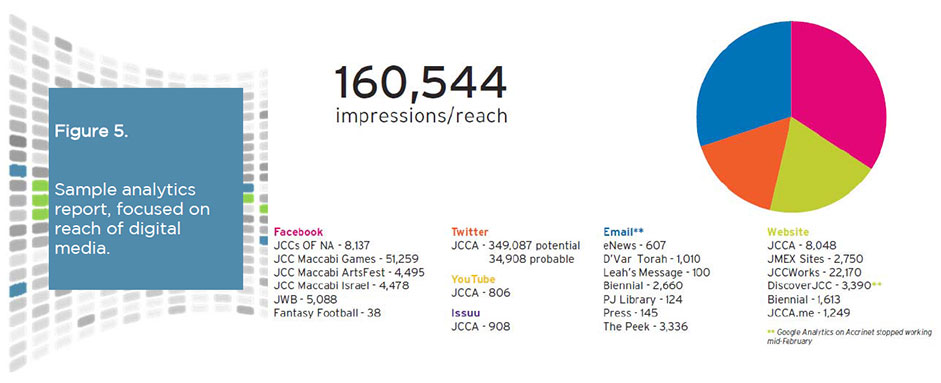
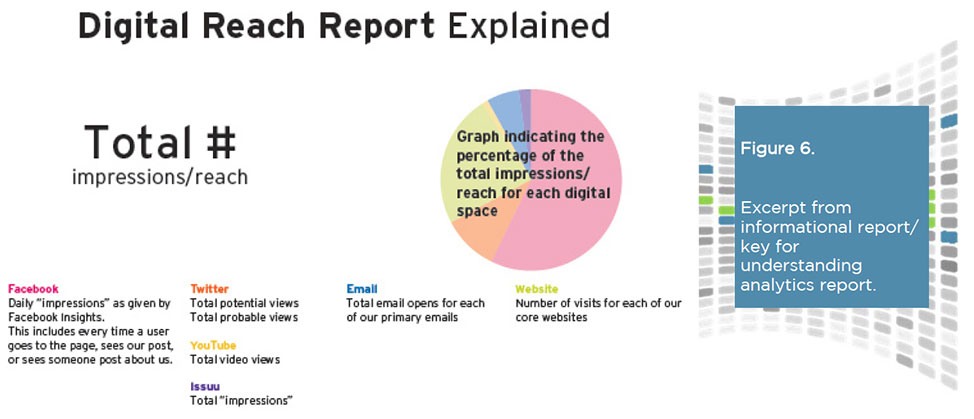
Highlights, Part 4
The examples above, we think, are compelling examples of the ways in which web analytic data, specifically, is put to use in ways that clearly situate the writers involved as data users. We might also situate ourselves as data users. For instance, citation and download data is, more and more, crucial for scholars in the humanities to attend to. Many institutions use metrics provided by Google Scholar and other tools to map faculty productivity, distribution, and reach of their work. Figure 7 includes a sample citation and download count report generated from Scopus and ScienceDirect data, taken from an article in which the authors compared citation frequency to download numbers.
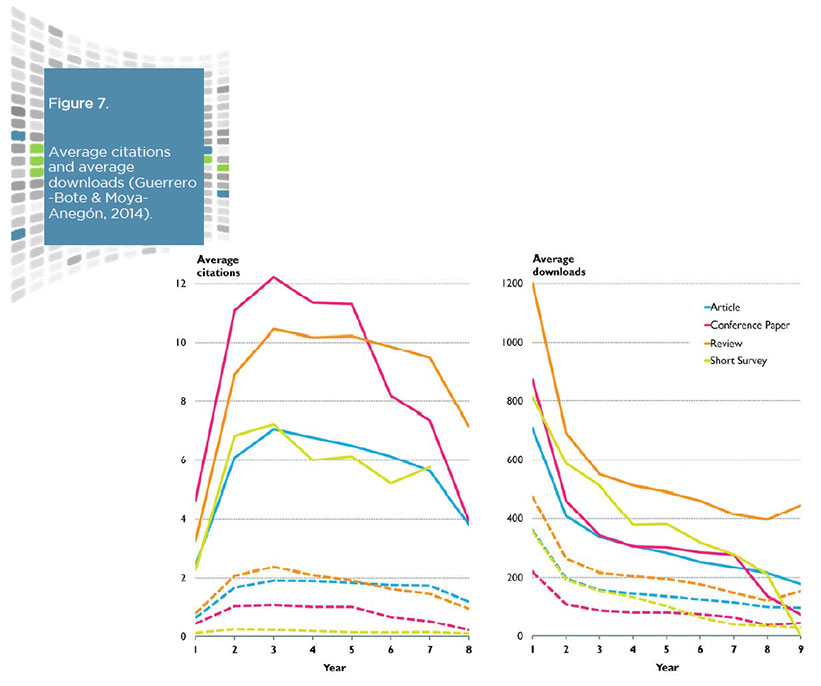
Implications and Conclusions
Technological and cultural shifts over the last 20 years have shown us that students are no longer unaware consumers of digital information, and that, as Cynthia Selfe and Richard Selfe (1994) so iconically illustrated, technological interfaces were and continue to be grounded in specific ideologies. As we continue looking to the future of digital writing, publishing, and making, we want to emphasize students' active roles in not only sharing, but also building and putting to use the technologies they and their clients interact with to accomplish everyday composing tasks.
One way to integrate digital surveillance issues and privacy conversations into digital rhetoric courses at various levels is to use tools such as Zada's (2011) Take this Lollipop to help students understand the potential impact of sharing their information online. In terms of using user data, our role as teachers of rhetoric and digital writing is to help students both understand and practice ethical uses of digital information. In digital rhetoric courses, we can continue teaching what James Porter and Heidi McKee (2008) described as "a rhetorical, case-based approach to ethical decision making" (p. 11). This approach prepares students to not only understand best practices for sharing their own information online, but also to navigate professional scenarios in which these best practices might come into play.
Our students are active contributors to digital landscapes. Through their internships and careers in professional writing, the students in our classrooms do and will continue to shape the technologies we use on an everyday basis. In turn, our job is not to tell students which systems and technologies to avoid, but rather to help them rhetorically situate decisions that involve humans, information, and technologies.
Priority Next Steps
- • Continue helping students understand how their online data is being collected and distributed, but also push students to rhetorically analyze why these collections and distributions are happening. Engage students in conversations about the end-goal of data collection, and the ethical implications of the decisions made about the data and how it is used.
- • Engage students in gaining familiarity in the rhetorical moves made in reports by gathering and analyzing a wide range of reports. Areas of analysis include analytics report designs, content categories, reporting moves, audience (e.g., executive boards, marketing departments, academic researchers), address tactics, and more.
- • Have students practice roles as designers and makers, and engage them in considering, for instance, what tools and software they would likely create as professionals, and what data they would need as designers of these tools in order to make their resources useful to others.
- • Have students understand and practice usability testing as one method of data gathering. Engage them in comparisons of usability test data versus web analytic data. Invite them to consider and discuss how usability testing data is important information to designers, and what ethical choices are at stake across development and testing phases.
Writing students require experience in ethically gathering and using data. Rhetoric—especially the ways in which we attend deeply and directly to audience, purpose, and context, and the ways in which we, as writers, act as user advocates—is a tool we can use to engage students in data use. Writing classrooms (especially those focused on professional or technical communication) are spaces where such engagement can, and should, happen.
Acknowledgments
Thanks to Natalie Kozlowski, Alexandra White, and Joe Morsello—all three alums of Michigan State University's Professional Writing program and web/digital management specialists—for sharing their experiences, expertise, and materials related to web user analytics.
References
Amidon, Timothy R., & Reyman, Jessica. (2014). Authorship and ownership of user contributions on the social web. In Dànielle Nicole DeVoss & Martine Courant Rife (Eds.), Cultures of copyright (pp. 108–124). New York, NY: Peter Lang.
Beck, Estee. (2015). The invisible digital identity: Assemblages in digital networks. Computers and Composition, 35, 125–140.
Guerrero, Vincente P., & Moya-Anegón, Félix. (2014, June). Download versus citations and the role of publication language. Research Trends, 37. Retrieved from http://www.researchtrends.com/issue-37-june-2014/downloads-versus-citations-and-the-role-of-publication-language/
Johnson-Eilola, Johndan. (2012). Polymorphous perversity and texts. Kairos: A Journal of Rhetoric, Technology, and Pedagogy, 16(3). Retrieved from http://kairos.technorhetoric.net/16.3/topoi/johnson-eilola/index.html
McKee, Heidi. (2011). Policy matters now and in the future: Net neutrality, corporate data mining, and government surveillance. Computers and Composition, 28, 276–291.
McKee, Heidi, & Porter, James E. (2008). The ethics of digital writing research: A rhetorical approach. College Composition and Communication, 59(8), 711–749.
Morsello, Joe. (2015, July 8). Infographic: Top 142 categories consumers searched for in past week. LSA Insider. Retrieved from http://www.lsainsider.com/infographic-top-142-categories-consumers-searched-for-inpast-week/archives/#sthash.Cg782yZL.dpbs
Selfe, Cynthia L., & Selfe, Richard J. (1994). The politics of the interface: Power and its exercise in electronic contact zones. College Composition and Communication, 45, 480–504.
Vee, Annette. (2010). Carving up the commons: How software patents are impacting our digital composition environments. Computers and Composition, 27(3), 179–192.